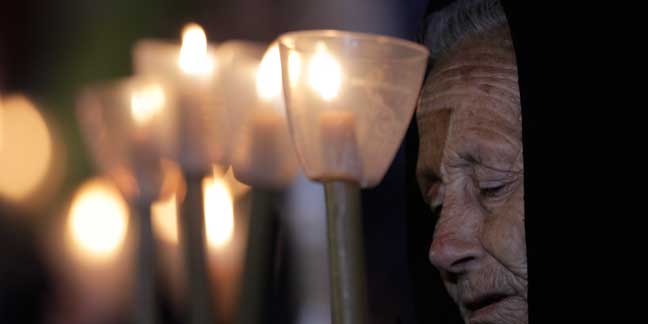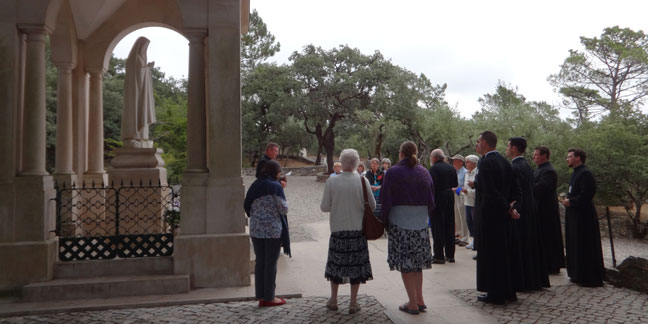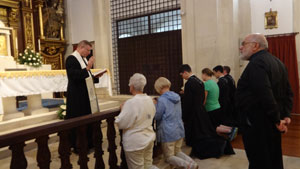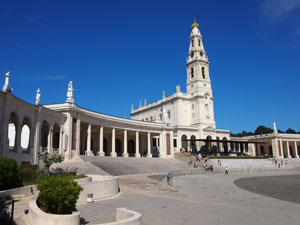 VATICAN CITY — When then-Cardinal Joseph Ratzinger met the press in 2000 for the formal release of the so-called Third Secret of Fatima, he said he knew many people would be disappointed.
VATICAN CITY — When then-Cardinal Joseph Ratzinger met the press in 2000 for the formal release of the so-called Third Secret of Fatima, he said he knew many people would be disappointed.
Almost 16 years later, at the beginning of a yearlong preparation for the 100th anniversary of the apparition of our Lady of Fatima in 2017, now-retired Pope Benedict XVI is still dealing with people not convinced the secret is really out.
An online journal called OnePeterFive published an article May 15 claiming that shortly after then-Cardinal Ratzinger released the secret and his commentary, affirming that it was the complete text, he told a German priest that, in fact, it was not.
"There is more than what we published," the article claimed the cardinal told Father Ingo Dollinger. The article went further: "He also told Dollinger that the published part of the secret is authentic and that the unpublished part of the secret speaks about 'a bad council and a bad Mass' that was to come in the near future."
A statement released May 21 by the Vatican press office said Pope Benedict "declares 'never to have spoken with Professor Dollinger about Fatima,' clearly affirming that the remarks attributed to Professor Dollinger on the matter 'are pure inventions, absolutely untrue,' and he confirms decisively that 'the publication of the Third Secret of Fatima is complete.'"
The Vatican's publication of "The Message of Fatima" in 2000 included a photocopy of the text handwritten in 1944 by Carmelite Sister Lucia dos Santos, the last survivor of the three children who saw Mary at Fatima in 1917.
Speculation naturally swirls around secrets, and when a secret is held for decades, the assumptions gain ground and followers.
The common message of Marian apparitions throughout the centuries has been: pray and convert. But a message read only by a few popes and their closest aides? There had to be something more to it to justify keeping it so secret, many people thought.
When Cardinal Ratzinger presented the text in the Vatican press office June 26, 2000, he told reporters that the choice of St. John XXIII and Blessed Paul VI to withhold publication and St. John Paul II's decision to delay it was not a "dogmatic decision but one of prudence.''
But, he said, "looking back, I would certainly say that we have paid a price'' for the delay, which allowed the spread of apocalyptic theories about its contents.
Meeting the press that day, the first words out of his mouth were: "One who carefully reads the text of the so-called third secret of Fatima will probably be disappointed or surprised after all the speculation there has been."
The text, he said, uses "symbolic language" to describe "the church of the martyrs of the century now past," particularly the victims of two world wars, Nazism and communism.
But what was most difficult for many to believe after the secret spent more than 40 years in a Vatican vault was what the text did not contain. "No great mystery is revealed," Cardinal Ratzinger said. "The veil of the future is not torn."
In a 1996 interview with Portugal's main Catholic radio station, the cardinal -- who already had read the secret -- tried the reasonable, tradition-based approach to pointing out what was and was not in the message. "The Virgin does not engage in sensationalism; she does not create fear," he said. "She does not present apocalyptic visions, but guides people to her Son."
Cardinal Ratzinger became Pope Benedict XVI five years after the text was published. If there was more to the secret, he had eight years of complete freedom as supreme pontiff to share what supposedly was withheld.
Marianist Father Johann Roten, a former student of then-Father Joseph Ratzinger who for years headed the Marian Research Institute at the University of Dayton, said there is "no doubt there is truth" in what many Fatima devotees see as "the moral decline in the church."
"The difficulty is in the method" many of them choose to convince others of the need for conversion and prayer, Father Roten said in an email response to questions.
"The method tends to be magico-ritualistic, based on the conviction that a particular act," such as the consecration of Russia performed in a particular way, "will solve all problems," he said.
"Apparitions always stress the message of Christ," Father Roten said. Mary urges "prayer, conversion and practical manifestations of one's faith."
"Warnings are part of the message, not always, but especially in times of imminent social catastrophe," including Fatima before the Russian Revolution, he said. "Unfortunately, these general messages are frequently overlooked. Instead the attention is given to sensationalism -- a rosary turning golden -- or apocalypticism -- doomsday warnings -- which never represent the essential part and reasons of such events."
Speaking to reporters traveling with him to Fatima in 2010, Pope Benedict repeated what he had said 10 years earlier: The text was open to interpretation, but the heart of the Fatima message was a call "to ongoing conversion, penance, prayer and the three theological virtues: faith, hope and charity."
Yes, he said, the church constantly is under attack -- "attacks from within and without -- yet the forces of good are also ever present and, in the end, the Lord is more powerful than evil and Our Lady is for us the visible, motherly guarantee of God's goodness, which is always the last word in history."
— Cindy Wooden, Catholic News Service
 CHARLOTTE — Carrying on a tradition dating back to 1985 in the Diocese of Charlotte, the Te Deum Foundation is taking pilgrims to Fatima, Portugal, this July – and this year’s pilgrimage is expected to be particularly special.
CHARLOTTE — Carrying on a tradition dating back to 1985 in the Diocese of Charlotte, the Te Deum Foundation is taking pilgrims to Fatima, Portugal, this July – and this year’s pilgrimage is expected to be particularly special.
That’s because this year marks the 100th anniversary of the apparitions of the Blessed Virgin Mary to three shepherd children in Fatima. In honor of the centennial, the Te Deum Foundation will take two busloads of pilgrims to Fatima July 19-Aug. 1.
Embarking on the 7,746-mile roundtrip journey across the Atlantic Ocean will be a group of clergy, seminarians and laity to visit the National Shrine of Our Lady of Fatima.
Billie Mobley, president of the Te Deum Foundation, whose mission is to provide for the spiritual and material needs of seminarians, expects 17 seminarians from the Charlotte diocese and other dioceses will participate in the pilgrimage. There are a few spots remaining on the trip for anyone who would like to go, Mobley said.
The annual pilgrimage to Fatima began in 1985 under the guidance of former Benedictine Abbot Edmund McCaffrey of Belmont Abbey working with Kathleen Potter, a parishioner of St. Patrick Cathedral. Mobley recalls the late abbot’s deep devotion to Our Lady of Fatima, and his travels around the country introducing people to the message of Fatima and encouraging people to pray for religious vocations.
Charlotte’s former Bishop John Donoghue went on one of the pilgrimages with Abbot McCaffrey, and at some point later also took pilgrims to Fatima, Mobley noted.
The tradition was carried forward in 2007 by the Te Deum Foundation – comprised of priests and laity who had been spiritual children of Abbot McCaffrey and who made the pilgrimage with him in years past. They took on an additional goal: besides spreading the message of Fatima, they wanted to introduce seminarians to Fatima as part of their spiritual formation.
“We knew the value for the priests who went (some as seminarians) and we looked at our mission statement and thought that this is a fulfilment of that. We wanted to focus on taking seminarians and laity and continue the summer pilgrimage in honor of Abbot McCaffrey,” Mobley explained.
Everything that has transpired over the past 11 years, she said, has “had intervention from heaven.” From the earliest days when she didn’t know any Portuguese, and divine providence unexpectedly put her in touch with a Portuguese man in the diocese who is from a village near Fatima, Mobley said she has felt the hand of God and the assistance of Our Lady in this effort to shepherd pilgrims to Fatima.
Father Christopher Roux, rector and pastor of St. Patrick Cathedral in Charlotte, is one of the priests who made the pilgrimage 15 years ago with Abbot McCaffrey and has regularly helped lead the yearly pilgrimages with Father John Putnam, pastor of St. Mark Church in Huntersville, as co-spiritual director.
“My first pilgrimage was in July of 2002 and except for the pilgrimage of 2008, I have been every year since,” Father Roux said. “Every year the experience is different.
“The first time I exited the bus in Fatima, I had a sense of coming home. My first experience was more like getting to know an old friend. Everywhere I went, it seemed like I was simply being reminded of things that were already in my heart.”
“Every year after the experience is a little different,” he continued. “Sometimes it is a simple visit to a beautiful place, and sometimes the grace awaiting me is surprising and calls me even deeper into my priestly service.”
Over the many years he has been associated with the pilgrimage, he has witnessed many people grow in their knowledge, appreciation and – most importantly – in love with Our Blessed Mother, he said.
“Of course, it is always the mission of Our Lady to introduce us to her son, Jesus, and encourage us to ‘do whatever He tells you.’ This is very much evident in the message and mission of Fatima. We are called to become concerned with our fellow man and the conversion of sinners and salvation of souls,” he said.

 “The message of Fatima so often is spoken of as a message of peace. It is not simply the absence of conflict, but the peace which comes from rejecting sin and embracing virtue. This peace will remain even when the world around us becomes more and more violent.”
“The message of Fatima so often is spoken of as a message of peace. It is not simply the absence of conflict, but the peace which comes from rejecting sin and embracing virtue. This peace will remain even when the world around us becomes more and more violent.”
Deacon Brian Becker of St. Matthew Church in Charlotte went on the Te Deum pilgrimage in 2012 with fellow seminarians Deacon Chris Bond, Deacon Peter Ascik and Colton Brown.
“Prior to going on the pilgrimage, I had experienced a great deal of growth in my faith during my first year in seminary,” Deacon Becker recalled. “I had grown a great deal in learning about the Church’s teachings on the role and person of Mary, but I had little personal experience of her.
“My favorite part of the pilgrimage was the chance to simply spend a lot of time in Fatima. You can really tell when a place has been changed by the life of a saint or the appearance of Our Lady. These places take on the holiness of these people, and they draw pilgrims into that holiness, into a personal experience of it,” he said.
“Spending time in this place that Our Lady visited so frequently, I was able to come into contact with her and get to know her better. I understood better her role in our life of faith, pointing always to loving her Son. I learned also of the special care that she has for priests, who are configured to the image of her Son. Her intercession, her Immaculate Heart, has been powerful for me and for so many of my brothers in the seminary, to mold us into men after the Sacred Heart of her Son,” he added.
Last July, Jim and Karen Verney of Charlotte experienced Fatima for the first time. The couple had traveled to Europe a number of times, but Fatima was different for them. They were among a group of 28 pilgrims that included five seminarians from Charlotte, diocesan priests and other seminarians.
“We thought that it being the 100th anniversary of the angels appearing to Lucia, Jacinta and Francisco, it would be fun, educational and spiritual. The trip turned out to be all three and more as we traveled for almost two weeks together,” Jim Verney said.
The camaraderie among the pilgrim group was outstanding, Verney added. “We had time to sit and talk, dine, pray and worship together. We made 26 new friends from the experience.”
He said the last time he had been in the company of so many religious was when he was a senior at Detroit Catholic Central High School, where 25 Brazilian priests and seminarians taught more than 1,000 boys in four grades.
“So it was great to travel with so many holy men. The seminarians were extremely impressive because of their focus, their love of Christ, their spirituality and their maturity,” Verney said.
He and Karen also enjoyed the universality of the Church they witnessed in Fatima, as one day they wandered in to a Mass being said in Portuguese. “We didn’t understand the language but we did understand the Mass, and we felt right at home.”
A humorous and unexpected challenge presented itself on the pilgrimage when they had to figure out how to do their laundry in a local laundromat, where instructions were all in Portuguese.
“I will always remember Father Dominguez, four seminarians, Karen and I carrying our laundry a few blocks to the new laundromat,” he recalled. “It took us a few funny moments to figure out the Portuguese way to handle the washers and dryers, but together we figured it out and proudly walked back to Domus Pacis Hotel with a week’s worth of clean clothes.”
Verney said their time spent on pilgrimage in Fatima has impacted him and his wife forever, and they hope to return someday. In the meantime, they have another goal: “Our bigger mission is to assist the young seminarians as we can to achieve priesthood.”
One of those seminarians who has made the Te Deum pilgrimage to Fatima is transitional Deacon Bradley Nursey of the Diocese of Gaylord, Mich. He grew up in a home where his father always had a devotion to Our Lady of Fatima.
“So I grew up under the influence of Our Lady of Fatima in the house. It was never dominating, but was always there…I believe that it is important to make our lives completely Marian. This is very pleasing to God and a sure path to heaven. As part of this effort I wanted to visit Fatima,” Deacon Nursey explained.
The trip had an incredible impact on his vocation, he said. “It really helped to bolster it and give it a sharper Marian focus. I had already been contemplating under which of Our Lady’s titles I would like to consecrate my priesthood to her. My trip to Fatima made this choice evident.
“Also, I developed a real attraction to the children of Fatima – especially Francisco. I have been enamored with his desire to suffer simply to give consolation to Our Lord. We are very concerned about receiving God’s mercy, which is indeed a great thing, for we are all lost without God’s mercy. But through our own sufferings and tears, many of us forget the tears of Our Lord. Little Francisco did not. I want to be with Francisco.”
It appears Our Lord, perhaps with a request from Our Lady, will fulfill Deacon Nursey’s desire to be ordained to the priesthood on the 100th anniversary of the apparitions of Fatima on May 13. Gaylord Bishop Steven J. Raica has given consent to the May ordination at St. Mary’s Cathedral rather than the usual June date.
“Due to the gift of the swiftest and surest way to God being through Mary, the influence of Our Lady of Fatima growing up, and the fact that I would be ordained in the year of the 100th anniversary, made being ordained on the very day a great desire for me,” Deacon Nursey said.
He acknowledges this is a rare moment. “To have this opportunity is not just once in a lifetime. It is simply once. Period. And it looks like Our Lady is granting it!”
— SueAnn Howell, senior reporter
Travel to Fatima with Te Deum
For more information about the July pilgrimage to Fatima, reserve your spot on the trip, or make a donation to help sponsor a seminarian’s pilgrimage, go to www.tedeumfoundation.org/fatima. Questions? Email Billie Mobley at This email address is being protected from spambots. You need JavaScript enabled to view it. or call 336-765-1815. Deadline to register is March 30.

